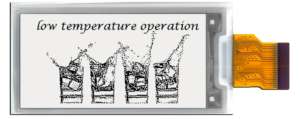 Pervasive Displays (PDi) announces a new TFT active matrix Electronic Paper Display (EPD) module that provides a dynamic, easily-readable display of information down to freezing temperatures of -25° C (-13 °F). This low temperature, low power, high-resolution display module is the 2.13-inch E2213HS091. The module is highly integrated, with a built-in timing controller and other support circuitry to help designers speed up product development.
Pervasive Displays (PDi) announces a new TFT active matrix Electronic Paper Display (EPD) module that provides a dynamic, easily-readable display of information down to freezing temperatures of -25° C (-13 °F). This low temperature, low power, high-resolution display module is the 2.13-inch E2213HS091. The module is highly integrated, with a built-in timing controller and other support circuitry to help designers speed up product development.
The display’s remarkable low temperature operation (from -25° C to 10° C), ultra-low power consumption, clarity and ease-of-integration make it suitable for new signage, labeling, tagging and informational applications in sectors and settings such as public information, retail, healthcare, transportation, warehousing, laboratories, cold-chain logistics, and food packaging and storage. Typical application areas include electronic shelf labels (ESL), Internet of Things (IoT) devices, retail freezers, e-POP (point of purchase) and signage, electronic bulletins, and navigation.
“E-paper displays that work reliably in sub-zero temperatures are opening up a new frontier of applications as these products outperform older technologies,” said Scott Soong, CEO of Pervasive Displays. “We’re also making those new applications easier to develop, and reducing time to market, by using chip-on-glass technology to integrate the timing controller and other support circuits right onto the panel.”
The E2213HS091 uses TFT active matrix monochrome E Ink display panel technology. Text and graphics are sharp and clear thanks to the display’s high resolution. Unlike older LCD technology, E Ink displays provides a vibrant, natural light-readable display without needing a power-hungry backlight.
Thanks to its bi-stable nature, EPD module technology requires no power to maintain an image and very little power to update an image. Developers building applications around this new module can reduce their component costs and shorten their application development time, as features like the integrated chip-on-glass (CoG) timing controller and booster circuit reduce the need for external driving circuitry and cut down software development overhead.
To ensure the best image quality, fastest display update speed, and greatest reliability, the timing controller’s one time programmable (OTP) lookup table holds driving waveforms, which control the series of electrical impulses that change the color of the e-paper display’s pixels. PDi’s stored driving waveforms also help to simplify programming, and to ensure the pre-tested waveforms are ideally tuned.

Leave a Reply